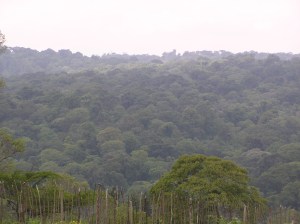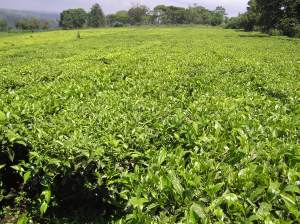Mary Mwendwa
July 16, 2012
Residents of Chepsir Tea zone settlement scheme cry foul over the effects of human-wildlife conflict, logging and charcoal burning on conservation efforts of the Chepsir forest in Kenya.
The famous forest is located in the South Western part of Mau block in Chepsir village, Kepkelion district in Kericho County.
Chepsir Tea Zone Settlement Scheme came into existence in 1962 after the British colonial government sold land to Kenyan government which later sold to people through Brookbond group of companies that practice tea farming in the region.

Despite the Mau restoration conservation efforts that have hit the national agenda, the forest community continues to face challenges that if not addressed urgently, the water tower will still face a threat of destruction.
From a distance, one is able to spot smoke from charcoal burning spots in the interior parts of the forest and also met several loggers packed timber on a tractors. A clear indication that some of these activities that destroy forest cover are still in existence.
This is leading to microclimate changes across the forest edges. A microclimate is the distinctive climate of a small-scale area, such as a garden, park, valley or part of a city.
Daudi Sigilai Arapmosik, a teenager and a resident here, who does part time comedy on a community Radio station nearby, notes that illegal logging and charcoal burning are common and serious and should be addressed urgently.
He confirmed that Kenya Forest Service has tried much but they have very few staff to patrol the forest. “If we had more forest guards may be the forest could not be destroyed by these charcoal burners and loggers” he laments.
Likewise, Magdaline Limo, mother of four in the Chepsir tea zone area says her biggest problem is the elephants that eat and destroy her crops. “Recently elephants invaded my small farm and destroyed maize worth one acre, my family depends on this farm, what can I do to stop these elephants coming to my farm?” she laments.
Many of the dwellers here, who are from the Kipsigis sub-tribe of the Kalenjin community, depend on ecosystem services from the forest. Many do farming, livestock rearing, beekeeping, and mixed crop farming. Chunks of maize plantations and tea dot the landscape in the area.
Being one of the Mau Complex blocks, it contains one of the largest Kenya’s water tower, located in the south western block, bordering Kericho and Bomet counties. The forest is both known for its indigenous and exotic tree species.
It is also a catchment are for several rivers including River Timbilil which serves the entire Kericho County, Birirbei, Kiplelachbei, Lelachbei among others.
Kuresoi, Chagaik, and Cheboswa are some of the neighboring forests of Chepsir. Chepsir dam and Sachoran form part of the wetlands in the region.
People living around Chepsir forest believe this is their only source of livelihood. Water from rivers, fodder for their livestock and rains of the crops are their main means of survival.

Since the government rolled out the Mau restoration process, many stakeholders have been involved in various campaigns ranging from tree planting exercises, education on importance of conserving the forest among others.
However for these efforts to have a lasting conservation solution, communities like the Chepsir Tea zone settlement scheme that have settled around the forest face challenges that make them resort to activities that destroy the entire mau ecosystem.
Mau is a catchment area of rivers: Ewaso Nyiro; Sondu; Mara and Njoro which feed some of the most important great Riftvalley lakes such as Nakuru and Natron and Lake Victoria in Nyanza.
Survival of all these ecosystems depend entirely on the Mau, therefore any activity that contributes to its degradation has huge local, regional and international implications.
Chepsir forest has continued to lose its indigenous tree species especially the cedar and podocarpus to charcoal burning.
Duncan Kibet, a village elder and farmer, notes that many of the illegal charcoal burners and loggers are people who don’t belong to the community around the forest. “It is sad that total strangers come to destroy this forest and we watch because we have no capacity to stop them, we only see them leave with products”.
Chanegs in the area’s microclimate are leading to favorable conditions for breeding of several disease vectors.
Now, as a community that depends of farming, many of the livestock keepers in this area face a challenge of pests that invade and transmit diseases to their livestock.
Daniel Rotich, a veterinary doctor and a member of Chepsir Environmental Conservation and protection Group, confirms that there are over twenty species of pests that transmit different strains of diseases to the livestock.
East Coast Fever, Babeosis (blue tick), Lumpy skin disease, heart water/Black quarter and rabbies are some of the diseases that are a big threat to the livestock in the region.
This spreads a huge economic impact on the farmer in terms of seeking treatment and loss if the livestock.
Mr.Rotich adds that at least one thousand livestock are lost through this annually.
However, the Kenya Forest Service has come up with mechanisms to help communities living around this forest through the Forest Act that came into force in 2007. Through this act, community based organizations have been registered as community Forest Associations (CFAs).
All these working together with Kenya Wildlife Service, Kenya Forest Working Group among other stakeholders to conserve the forest. Communities pay one hundred Kenya shillings monthly to access firewood from this forest on a daily basis.
Alphonse Rotich, a farmer and a Coordinator of Save The Mau Forests Conservation project, says Chepsir community has been very committed to conservation of the forest. Many of the farmers have more than two percent tree cover in their farms. He adds that there is need for the community to benefit from the Carbon Credits Projects which have been rolled out in some parts of the country.
This will help them benefit directly from their conservation efforts and spread the benefits further to other people, a move that will promote sequestration (sucking of carbon from the atmosphere) hence help in fighting climate change effects.
As Kenya struggles to achieve its millennium development goals by 2015, conservation and sustainable development remain a top priority in restoring catchment areas like Chepsir forest which need urgent intervention both at the community level and authority level.

